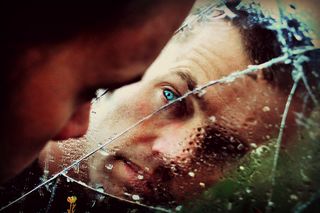
Narcissism
The Maddening Allure of the Fragile Bully
As much as narcissism looks like a solo act, it is better understood as a dance.
Posted March 12, 2019 Reviewed by Ekua Hagan

“The story changes, but one thing remains the same,” Christina told me. “He is always the victim, and he is always the hero.”
Christina and I were sharing a breakfast meeting to talk about the book I was writing—and her story. Christina had been with Jim 12 years and loved him, but, more and more, hated him. She was tired. Even as his bullying escalated, she told me, it was hard to walk away: “I thought of him like an orange. Like a navel orange, bumpy and bruised on the outside. If I could just peel the skin off, I could get to this delicious, juicy, fresh inside.” The archetypal narcissist is a crazymaker, at once needy and aggressive, desperate for love and yet rejecting of it, fragile child and bully. The relationship contract with the narcissist requires emptying the self and assuming the role of mirror and echo.
Christina had fallen into a destructive dance with a fragile bully, a vicious circle in which attempted solutions fed the problem. He saw her efforts to repair their interactions as evidence that she hated him, which hooked her into trying harder, which further aroused his paranoia. This is the maddening paradox of engaging a narcissist. We see the potential and we see the problem, and both are intoxicating.
For Christina, the potential was the kind and heroic man to whom she’d been given exclusive access. The problem—his blocked potential—was a special challenge entrusted to her. Jim was a generous and lovable man who consistently lied to her but had never been physically abusive—until he inflicted a blow that required her to undergo brain surgery. He was now out of her house but not out of her mind. The intoxicating pull was still there. They were talking every day.
The fragile bully paradox is at the heart of pathological narcissism. Jim seemed vulnerable, misunderstood, and deserving of special consideration. He also was “full of himself” and more than willing to sacrifice truth and loyalty in favor of attention and power. And when Christina confronted his lies, Jim made himself her victim, pressuring her to abandon her own interests and protect him.
As much as destructive narcissism consumes relationships, American culture has a particular talent for feeding the beast. Where there is narcissism, there is drama, and reality TV is ready to capture it. Divas with big jewelry and dyed hair, so-called victims whose attacks on others are always justified, spew venom to the camera. Slighted bullies. Commentators with their authoritative take on the world get more and more room to openly insult the object of their commentary. Bullies only defending their positions. A billionaire tycoon flaunts his power over his celebrity staff, barking out “You’re fired!” as the recurring punchline. Bully by virtue of position. Said tycoon becomes a presidential candidate in an election marked by low blows justified as self-defense, and the drama of the fragile bully finds a home in the White House.
It is convenient to sit back and watch the narcissistic displays, admiring or cringing, but doing no more than reacting. As much as problematic narcissism looks like a solo act, it is better understood as a dance.

To see ourselves as above narcissistic needs, while dehumanizing those who openly display these needs, is to walk right into the dance. In fact, a recent study showed that viewers who indulge in media showcases for narcissism, such as reality TV and political talk shows, tend to score higher on a scale measuring narcissism (Lull & Dickinson, 2016). And though President Trump has been an easy focal point for anxieties about narcissism, we can only single him out when we forget that he is a freely elected representative, or when we ignore studies that show increasing levels of narcissism among U.S. presidents (Watts et al., 2013) or disregard the immense appeal of narcissistic drama. Whatever part we may play in the dance, narcissism is us. And while our culture exhibits an increased tolerance for destructive narcissism, that is only part of the story. Contemporary research by Craig Malkin and his colleagues affirms what pioneers like Heinz Kohut first recognized: Narcissism does not need to be unhealthy, and the absence of narcissism is as debilitating as its destructive counterpart. The problem is, destructive narcissism is designed to captivate, and in our society, it seems to be getting a good deal of traction. How do we restore health to a society that indulges the destructive forces of narcissism? How do we contend with our own appetites for narcissistic drama? How do we deal with the fragile bullies in our lives—and in ourselves?
Excerpted from Fragile Bully: Understanding Our Destructive Affair With Narcissism in the Age of Trump by Laurie Helgoe, Ph.D. Copyright ©2019.
References
Lull, R. B., & Dickinson, T. M. (2016). Does television cultivate narcissism? Relationships between television exposure, preferences for specific genres, and subclinical narcissism. Psychology of Popular Media Culture, 7(1), 47-60. See also Reiss, S., & Wiltz, J. (2004). Why People Watch Reality TV. Media Psychology, 6(4), 363-378.
Malkin, C. (2015). Rethinking narcissism: The secret to recognizing and coping with narcissists. New York: Harper Perennial.
Watts, A. L., Lilienfeld, S. O., Smith, S. F., Miller, J. D., Campbell, W. K., Waldman, I. D.,…Faschingbauer, T.J. (2013). The double-edged sword of grandiose narcissism: Implications for successful and unsuccessful leadership among U.S. Presidents. Psychological Science, 24(12), 2379 – 2389.
Helgoe, L. (2019). Fragile bully: Understanding our destructive affair with narcissism in the age of Trump. New York: Diversion Books.

